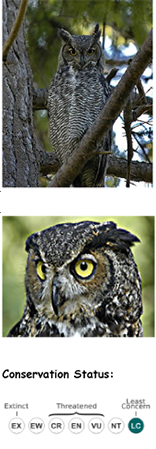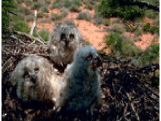Learn About Great Horned Owls
The Great Horned Owl (Bubo virginianus), is a large owl native to the Americas. It is an adaptable bird with a vast range. Indeed, it is the most widely-distributed true owl of the Americas, though it is not as widespread as the Barn Owl.
Individual Great Horned Owls range in length from 46-68 cm and have a wingspan of 101-153 cm. An average adult weighs about 3.1 lbs (1400 g). Generally the larger individuals are found towards the Polar regions and smaller ones towards the Equator.
Adults have large ear tufts, a reddish, brown or gray face and a white patch on the throat. The iris is yellow, except in the South American Great Horned Owl where it is amber. The ear tufts are not actually ears, but simply tufts of feathers that they use as a mean of communication. The underparts are light with brown barring; the upper parts are mottled brown. The legs and feet are covered in feathers up to the talons. There are individual and regional variations in color; birds from the sub-Arctic are a washed-out, light-buff color, while those from Central America can be a dark chocolate brown.
Their call is a low-pitched but loud ho-ho-hoo hoo hoo. Young owls make hissing or screeching sounds that are often confused with the calls of Barn Owls.
The breeding habitat of the Great Horned Owl extends from subarctic North America through much of Central America and South America south to Tierra del Fuego. They are absent from southern Guatemala, El Salvador and Nicaragua to Panama in Central, and Amazonia and the southwest in South America, as well as from the West Indies and indeed most off-shore islands.
Within their habitat they can take up residence in trees that include deciduous, coniferous, and mixed forests, tropical rainforests, pampas, prairie, mountainous areas, deserts, subarctic tundra, rocky coasts, mangrove swamp forests, and some urban areas. It is less common in the more extreme areas (i.e. the heart of the deserts, extremely dense rainforests and in montane regions) and missing from the high Arctic tundra. All mated Great Horned Owls are permanent residents of their territories, but unmated and younger birds move about a lot in search of company and a territory, and leave regions with little food in winter.
Owls have spectacular binocular vision allowing them to pinpoint prey and see in low light. The eyes of Great Horned Owls are nearly as large as those of humans and are immobile within their circular bone sockets. Instead of turning their eyes, they turn their heads. Therefore, their neck must be able to turn a full 270 degrees in order to see in other directions without moving its entire body.
An owl’s hearing is as good – if not better – than its vision; they have better depth perception and better perception of sound elevation (up-down direction) than humans. This is due to owl ears not being placed in the same position on either side of their head: the right ear is typically set higher in the skull and at a slightly different angle. By tilting or turning its head until the sound is the same in each ear, an owl can pinpoint both the horizontal and vertical direction of a sound.
These birds hunt at night by waiting on a high perch and swooping down on prey. Prey is quite variable, but is predominantly small to medium-sized mammals such as rats, squirrels, mice, moles, voles, marmots, hares, rabbits, skunks, shrews, bats, weasels, gerbils and even porcupines.
These birds also have 500 pounds per square inch of crushing power in their talons. An average adult human male has about 60 pounds per square inch in his hands.

Scientific Classification:
- Kingdom: Animalia
- Phylum: Chordata
- Class: Aves
- Order: Strigiformes
- Family: Strigidae
- Genus: Bubo
- Species: B. virginianus

References: * Accordi, Iury Almeida & Barcellos, André (2006): Composição da avifauna em oito áreas úmidas da Bacia Hidrográfica do Lago Guaíba, Rio Grande do Sul [Bird composition and conservation in eight wetlands of the hidrographic basin of Guaíba lake, State of Rio Grande do Sul, Brazil]. Revista Brasileira de Ornitologia 14(2): 101-115 * Banks, R.C.; Cicero, C.; Dunn, J.L.; Kratter, A.W.; Ouellet, H.; Rasmussen, P.C.; Remsen, J.V. Jr.; Rising, J.A. & Stotz, D.F.) (2000): Forty-second supplement to the American Ornithologists’ Union Check-list of North American Birds. Auk 117(3): 847–858. * BirdLife International (BLI) (2008). Bubo virginianus. 2008 IUCN Red List of Threatened Species. IUCN 2008. Retrieved on 18 November 2008. * Dickerman, Robert W. (2004): Notes on the type of Bubo virginianus sclariventris. Bull. B.O.C. 124(1): 5-6. * Holt, Denver W.; Berkley, Regan; Deppe, Caroline; Enríquez Rocha, Paula L.; Olsen, Penny D.; Petersen, Julie L.; Rangel Salazar, José Luis; Segars, Kelley P. & Wood, Kristin L. (1999): 69. Great Horned Owl. In: del Hoyo, J.; Elliott, A. & Sargatal, J. (eds): Handbook of Birds of the World (Volume 5: Barn-owls to Hummingbirds): 185, plate 10. Lynx Edicions, Barcelona. * Howard, Hildegarde (1947): A preliminary survey of trends in avian evolution from Pleistocene to recent time. Condor 49(1): 10-13. * Houston, C. S., Smith, D. G. & Rohner, C. (1998): Great Horned Owl (Bubo virginianus). In: Poole, A. & Gill, F. (eds.): Birds of North America 372. Academy of Natural Sciences, Philadelphia, PA & American Ornithologists’ Union, Washington, D.C. Online version, retrieved 2006-DEC-05.

